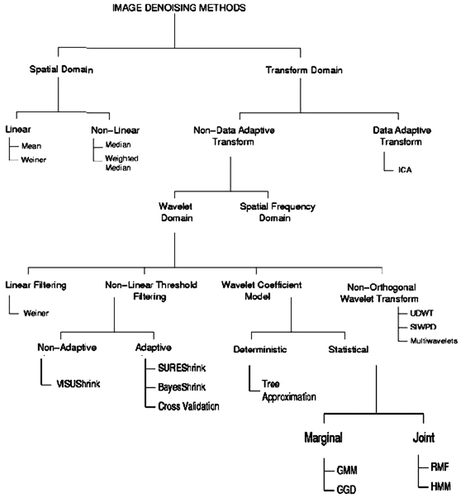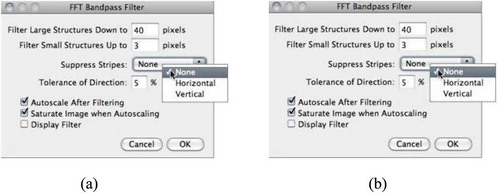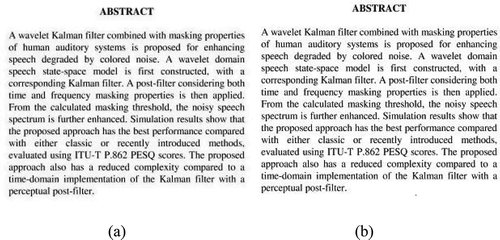Abstract
The research to come out with effective and noise-free images is still fresh despite several years’ efforts. Even though, recently, several methods have been proposed, each approach has its own merits and limitations. Moreover, outstanding performances are exhibited for the tailored applications but fail in general and create several flaws and blur images of fine structures. The purpose of this study is to compare achievements thus far in the area of nonnatural documents image denoising approaches. Accordingly, existing techniques are organized into nonhomogeneous categories and detailed comparison is exhibited with examples. Finally, remaining problems and possible future directions in the domain of document images denoising are suggested.
INTRODUCTION
Noise removal from natural and nonnatural images is a chronological as well as a persistant problem in the domain of image processing. It cannot be avoided, and noised images reduce optimal character recognition (OCR) accuracy significantly. Hence, it is normally included in all preprocessing steps. These applications include OCR, offline script recognition, character segmentation, object tracking, image segmentation, and classification. Paper documents are usually scanned and these scanned images are tainted with noise. The noise usually comes from different sources such as dirt on paper or lens, moisture on the lens, or physical dealing of papers. Moreover, noise is also introduced by transmission errors and compression. This noise might cause serious problems in the transferring of these images into ASCII codes during the OCR process. Additionally, significant features of the images are corrupted because of noise and causes for image degradation that significantly reduce OCR accuracy. Hence, efficient image denoising techniques are mandatory in order to compensate for data corruption to level out further processing of image segmentation and classification.
Document images might be infected by several classes of document noise because of physical dealing of papers or low quality of the scanning devices (Rehman, Saba, and Sulong Citation2010). These noises consist of salt and pepper noise (Abdel-Dayem, Hamou, and El-Sakka Citation2004), shadow noise (Ping, Lihui, Alex Citation2000), salient noise, and white-line dropout noise (Huang and Zhu Citation2010).
CURRENT IMAGE DENOISING APPROACHES
The literature is full of image denoising approaches and it is difficult to organize them into heterogeneous classes. Currently, all techniques reported as state of the art could be organized into two classes: spatial filtering methods and transform domain filtering methods (Motwani, Gadiya, and Motwani Citation2004), as exhibited in .
FIGURE 1 Hierarchical structure of current image denoising approaches (Motwani et al. Citation2004).

Spatial Filters
The spatial filters are composed of linear and nonlinear filters, detailed in the following sections.
Linear Filters
The linear filters are easy to implement, however, they are best applicable for random noise detection and removal. Other than that, they blur edges and remove fine detail and lines, so the efficiency is not good (Liying, Lixin, and Chew Citation2001). To rectify inherited drawbacks of mean filters, the Wiener filtering technique is implemented (Farahanirad et al. Citation2011). Nonetheless, the Wiener filtering technique removes the noise, yet for text and blurring of edges, it can work only under the condition of smooth underlying signals. Furthermore, it cannot work without details of the noise spectra and the actual image (Xing-mei et al. Citation2007; Saba, Rehman, and Elarbi-Boudihir Citation2011). exhibits results of linear filters on coin images.
Nonlinear Filters
Nonlinear filters are proposed to eliminate the shortcoming of linear filters to preserve structural information of an image and are used to denoise images without identifying noise. The most popular nonlinear filters are morphology and median filters.
The morphological operations are of two types: erosion and dilation, employed for salt-and-pepper noise identification and removal (Chen et al. Citation2011). However, morphological operations are suitable for natural images, yet, at the same time, create several problems for nonnatural images. Consequently, numerous researches have been conducted to enhance morphological techniques (Zheng and Kanungo Citation2001; Wang and Wu Citation2009; Mehrotra et al. Citation2012). Although significant efforts have been made, morphological techniques still have serious drawbacks (Al-Khaffaf, Talib, and Salam Citation2008; Bovik Citation1987).
Therefore, they are not feasible for nonnatural images (He et al. Citation2008; Nobi and Yousuf Citation2011), vector-median-filtering (Barni et al. Citation2009; Rehman, Kurniawan, and Saba Citation2011), image continuation algorithms, rank order filtering (Abreu et al. Citation1996), relaxed median filter (Hamza et al. Citation1999), switching median filter (Saba and Rehman Citation2012), progressive switching median filter (Wang and Zhang Citation1999), and improved switch median filter (Zhang and Karim Citation2002; Nikolova Citation2004; Chan, Ho, and Nikolova Citation2005; Dong and Fang Citation2006; Dalong, Simske, and Mersereau Citation2007). exhibits the effects of nonlinear filters on a document image.
Transform Domain Filtering
Transform domain filtering methods are categorized into nonadaptive and data-adaptive transform filters, based on their functionality. The first category of transform domain filtering is well discussed and experimented in the literature of the state of the art. Additionally, it is further subdivided into spatial-frequency filtering and wavelet domain.
Spatial-Frequency Filtering
Spatial-frequency filtering approaches employ low-pass filters and fast Fourier transform (FFT). Hence, such techniques are sluggish and highly dependable on the cut-off frequency and performance of filter function. Moreover, fast Fourier transform-based techniques generate artificial frequencies (Buades, Coll, and Morel Citation2005), as exhibited in .
Wavelet Domain Filters
Wavelets are popular because of their efficient image denoising output (Bala and Ertuzun Citation2002). Hence, wavelet transform-based approaches are effective for natural image denoising. Accordingly, the best results are yielded in the literature (Kuo and Johnston Citation2002; Choi and Baraniuk Citation2004; Zhou, Zhou, and Stewart Citation2006). However, these approaches failed to produce better results for nonnatural documents images (Dalong Citation2009), as exhibited in .
The authors recommend in-depth reviews in Ahmed Mashaly et al. (Citation2010), Seo et al. (Citation2007), and Saba, Sulong, and Rehman (Citation2011).
Data-Adaptive Transforms
This approach has proven to be a better option for natural and nonnatural image denoising applications (Mundher et al. Citation2014). Effects of data-adaptive transforms on natural and nonnatural images are exhibited in . However, these filters are also slow and high-memory demanding (Mahmoudi and Sapiro Citation2005). Recently, image denoising techniques reported in the literature with regard to the state of the art are employing support vector regression (Dalong Citation2009) and yield promising results for both categories (natural and nonnatural images).
CONCLUSION AND RECOMMENDATIONS
Efficiency of image denoising techniques could be measured using peak signal-to-noise ratio (PSNR) and signal-to-noise ratio (SNR). Additionally, visual impacts of the enhanced images are also used as a yard stick in a few of the image denoising research activities. Conversely, existing approaches consider the noise model to be Gaussian, although, in fact, this supposition is not always valid because of the huge variety of natural images, nonnatural images, and the source of the noise. Moreover, a perfect image denoising algorithm needs a priori knowledge of the noise in order to gather information about its variance to develop a model. This noise model is employed to compare the performance with different algorithms. However, practically, it is not possible to have an original image free of noise.
Certainly, wavelet-transform-based approaches evolved with effective tools to denoise an image because of their valuable attributes such as sparsity, multiresolution, and multiscale nature. Hence, potential achievements are reported in the literature based on the aforementioned approaches (Rehman and Saba Citation2011a,b).
Currently, multiwavelets filters improve only image denoising accuracy; yet, they increase memory consumption and are demanding with regard to high processor times. Additionally, computational complexity has been ignored in previous researches and researchers improved only accuracy, so this parameter should also be a focus of future research.
Additionally, the choice of primary resolution while using wavelet transform is a critical issue, and it might affect the success of the application (Rehman and Saba Citation2014). Therefore, researchers must be careful in selecting a true image denoising approach for true application and comparison on benchmark databases (Rehman et al. Citation2009).
Future research should focus on fused approaches; the mixture with intelligent approaches might produce promising results, particularly for nonnatural images. Actually, there is an utmost need to propose image denoising approaches that are equally suitable for both natural and nonnatural images. Currently, image denoising approaches are lacking these features and most are customized so one technique is suitable for its particular environment and fails for different images (Saba et al. Citation2014).
FUNDING
The authors extend their appreciation to the Deanship of Scientific Research at King Saud University for funding this work through research group no. RGP-264.
REFERENCES
- Abdel-Dayem, A. R., A. K. Hamou, and M. R. El-Sakka. 2004. Novel adaptive filtering for salt-and-pepper noise removal from binary document images. In Image analysis and recognition, LNCS 3212,191 –199.
- Abreu, E., M. Lightstone, S. Mitra, and K. Arakawa. 1996. A new efficient approach for the removal of impulse noise from highly corrupted images. IEEE Transactions on Image Processing 5 (6 ):1012 –1025.
- Ahmed Mashaly, S., F. Ezz Eldin AbdElkawy, A. Tarek Mahmoud. 2010. Speckle noise reduction in sar images using adaptive morphological filter. 10th international conference on intelligent systems design and applications. IEEE.
- Al-Khaffaf, H., A. Z. Talib, and R. A. Salam. 2008. Removing salt-and-pepper noise from binary images of engineering drawings. Paper presented at the 19th International Conference on Pattern Recognition, ICPR 2008,1 –4. Florida, 8–11 December.
- Bala, E., and A. Ertuzun. 2002. Applications of multiwavelet techniques to image denoising. In Proceedings of the international conference on image processing, vol.3: 581 –584. IEEE.
- Barni, M., F. Buti, F. Bartolini, and V. Cappellini. 2009. A quasi-Euclidean norm to speed up vector median filtering. IEEE Transactions on Image Processing 9 (10 ):1704 –1709.
- Bovik, A. 1987. Streaking in median filtered images. IEEE Transactions on Acoustics, Speech, and Signal Processing 35 (4 ):493 –503.
- Buades, A., B. Coll, and J. M. Morel. 2005. A review of image denoising algorithms with a new one multiscale modelling and simulation. SIAM Interdisciplinary Journal 4 (2 ):490 –530.
- Chan, R. H., C.-W. Ho, and M. Nikolova. 2005. Salt-and-pepper noise removal by median-type noise detectors and detail preserving regularization. IEEE Transactions on Image Progressing 14:1479 –1485.
- Chen, C., J. Wng, W. Quin, and X. Dong. 2011. A new adaptive weight algorithm for salt and pepper noise removal. Consumer Electronics, Communication and Networks 26 –29. IEEE International Conference on Consumer Electronics, Communications and Networks (CECNet). XianNing, China, 16–18 April.
- Choi, H., and R. G. Baraniuk. 2004. Multiple wavelet basis image denoising using Besov ball projections. IEEE Signal Processing Letters 11 (9 ):717 –720.
- Dalong, L., S. Simske, and R. M. Mersereau. 2007. Image denoising through support vector regression. IEEE International Conference on Image Processing 4:425 –428.
- Dalong, L. 2009. Support vector regression based image denoising image and vision computing. Acta Scientiarum Naturalium-Universitatis Pekinensis, 42(5):604.
- Dong, Y. Q., and X. S. Fang. 2006. An efficient salt-and-pepper noise removal. Acta Scientiarum Naturalium Universitatis Pekinensis, 42(5): 604 –612.
- Farahanirad, H., J. Shanbehzadeh, M. M. Pedram, and A. Sarrafzadeh. 2011. A hybrid edge detection algorithm for salt-and-pepper noise. Paper presented at the Proceedings of the IMECS. Proceedings of the International MultiConference of Engineers and Computer Scientists. Hong Kong, 16–18 March.
- Seo, H. J., P. Chatterjee, H. Takeda, and P. Milanfar. 2007. A comparison of some state of the art image denoising methods. Conference record of the forty-first asilomar conference on signals, systems and computers, 518 –522. IEEE.
- Hamza, A. B., P. Luque, J. Martinez, and R. Roman. 1999. Removing noise and preserving details with relaxed median filters. Journal of Mathematical Image Vision 11 (2 ):161 –177.
- He, K., J. Zhou, C. Liu, and R. Liu. 2008. An efficient salt-and-pepper noise removal on local edge-preserving function. In Proceedings of the international conference on embedded software and systems symposia, (ICESS symposia ‘08), 392–397. IEEE.
- Huang, S., and J. Zhu. 2010. Removal of salt-and-pepper noise based on compressed sensing. IEEE Electronic Letters 46 (17 ):1198 –1199.
- Kuo, S., and J. D. Johnston. 2002. Spatial noise shaping based on human visual sensitivity and its application to image coding. IEEE Transactions on Image Processing 11 (5 ):509 –517.
- Liying, F., F. Lixin, and L. T. Chew. 2001. Binarizing document image using coplanar prefilter. In Proceedings of the 6th international conference on document analysis and recognition, 34 –38. IEEE.
- Mahmoudi, M., and G. Sapiro. 2005. Fast image and video denoising via non-local means of similar neighbourhoods. IEEE Signal Processing Letters 12 (12 ):839 –842.
- Mehrotra, A., K. K. Singh, M. J. Nigam, and K. Pal. 2012. A novel algorithm for impulse noise removal and edge detection. International Journal of Computer Applications 38 (7 ):179 –187.
- Motwani, M. C., M. C. Gadiya, and R. C. Motwani. 2004. Survey of image denoising techniques. Paper presented at Proceedings of Global Signal Processing Expo and Conference GSPx, Santa Clara, CA, March.
- Mundher, M., D. Muhamad, A. Rehman, T. Saba, and F. Kausar. 2014. Digital watermarking for images security using discrete slantlet transform. Applied Mathematics and Information Sciences 8 (6 ):2823 –2830. doi:10.12785/amis/080618.
- Nikolova, M. 2004. A variational approach to remove outliers and impulse noise. Journal of Mathematics, Imaging and Vision 20:99 –120.
- Nobi, M. N., and M. A. Yousuf. 2011. A new method to remove noise in magnetic resonance and ultrasound images. Journal of Scientific Research 3 (1 ):81 –89.
- Ping, Z., C. Lihui, and K. C. Alex. 2000. Text document filters using morphological and geometrical features of characters. In Proceedings of the 5th international conference on signal processing, 1:472 – 475.
- Rehman, A., F. Kurniawan, and T. Saba. 2011.An automatic approach for line detection and removal without characters smash-up. Imaging Science Journal 59:171 –182.
- Rehman, A., D. Mohammad, G. Sulong, and T. Saba. 2009. Simple and effective techniques for core-zone detection and slant correction in script recognition. Paper presented at the IEEE International Conference on Signal and Image Processing Applications (ICSIPA’09), 15 –20. Malaysia, 12–14 August.
- Rehman, A., and T. Saba. 2011a. Document skew estimation and correction: Analysis of techniques, common problems and possible solutions. Applied Artificial Intelligence 25 (9 ):769 –787.
- Rehman, A. and T. Saba. 2011b. Performance analysis of segmentation approach for cursive handwritten word recognition on benchmark database. Digital Signal Processing 21 (3 ):486 –490.
- Rehman, A., and T. Saba. 2014. Neural network for document image preprocessing. Artificial Intelligence Review 42 (2 ):253 –273. doi:10.1007/s10462-012-9337-z.
- Rehman, A., T. Saba, and G. Sulong. 2010. An intelligent approach to image denoising. Journal of Theoretical and Applied Information Technology 17 (1 ):32 –36.
- Saba, T., and A. Rehman. 2012. Effects of artificially intelligent tools on pattern recognition. International Journal of Machine Learning and Cybernetics 4(2): 155–162. doi:10.1007/s13042-012-0082-z.
- Saba, T., A. Rehman, A. Altameem, and M. Uddin. 2014. Annotated comparisons of proposed preprocessing techniques for script recognition. Neural Computing and Applications. doi 10.1007/s00521-014-1618-9
- Saba, T., A. Rehman, and M. Elarbi-Boudihir. 2011. Methods and strategies on off-line cursive touched characters segmentation: A directional review. Artificial Intelligence Review. doi. 10.1007/s10462-011-9271-5.
- Saba, T., G. Sulong, and A. Rehman. 2011. Document image analysis: Issues, comparison of methods and remaining problems. Artificial Intelligence Review 35 (2 ):101 –118. doi:10.1007/s10462-010-9186-6
- Wang, Z., and D. Zhang. 1999. Progressive switching median filter for the removal of impulse noise from highly corrupted images. IEEE Transactions on Circuits and Systems II 46:78 –80.
- Wang, S. H., and C. H. Wu. 2009. A new impulse detection and filtering method for removal of wide range impulse noises. Pattern Recognition 42 (9 ):2194 –2202.
- Xing-mei, L., Y. Guo-ping, L. Xing-mei, and C. Liang. 2007. The image denoise based on soft-threshold and edge enhancement. Paper presented at the Second Workshop on Digital Media and its Application in Museum & Heritage, 53 –56. Germany.
- Zhang, S., and M. A. Karim. 2002. A new impulse detector for switching median filters. IEEE Signal Processing Letters 9:360 –363.
- Zheng, Q., and T. Kanungo. 2001. Morphological degradation models and their use in document image restoration. In Proceedings of the international conference on image processing, 1:193 –196. IEEE.
- Zhou, X., C. Zhou, and B. G. Stewart. 2006. Comparisons of discrete wavelet transform, wavelet packet transform and stationary wavelet transform in denoise pd measurement, data. In Proceedings of the international symposium on electrical insulation, 237 –240. IEEE.





